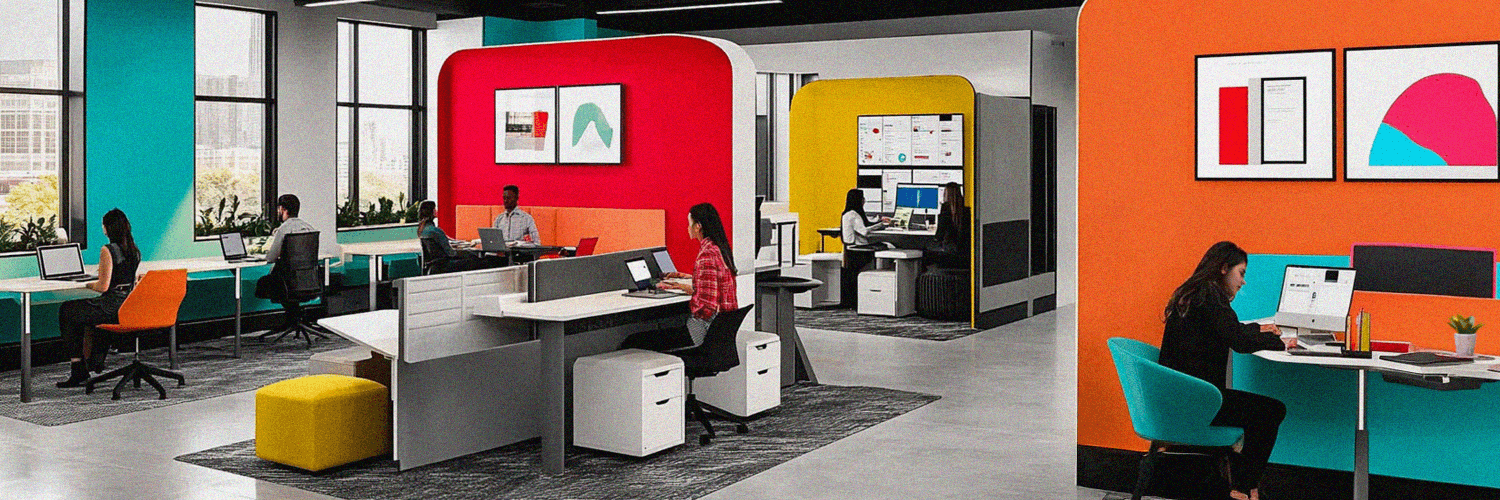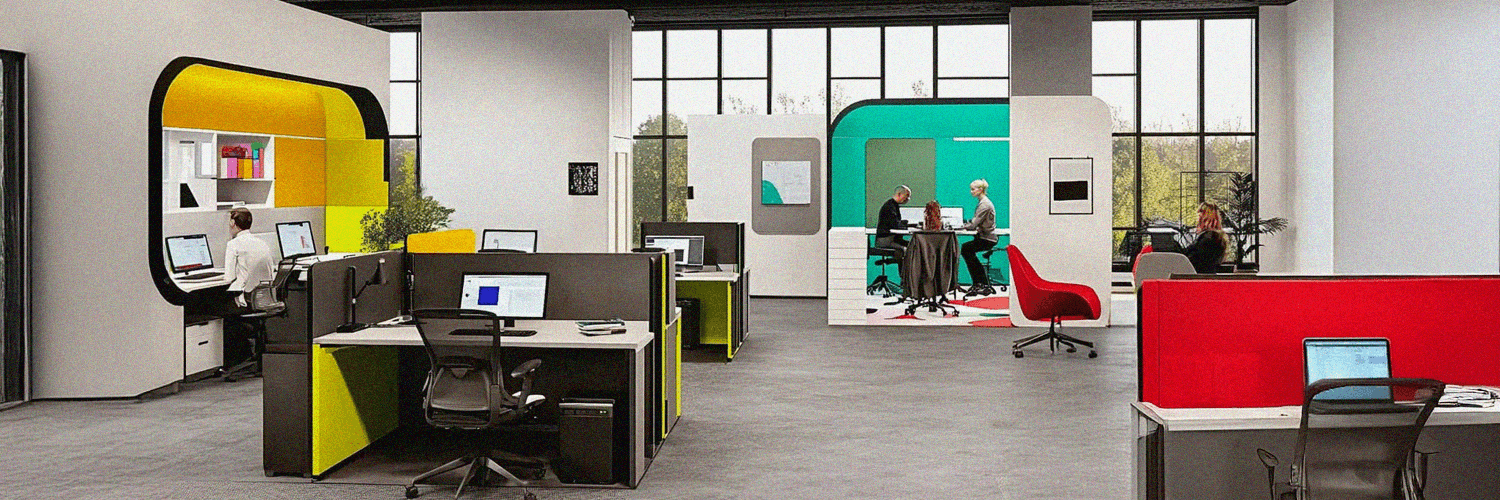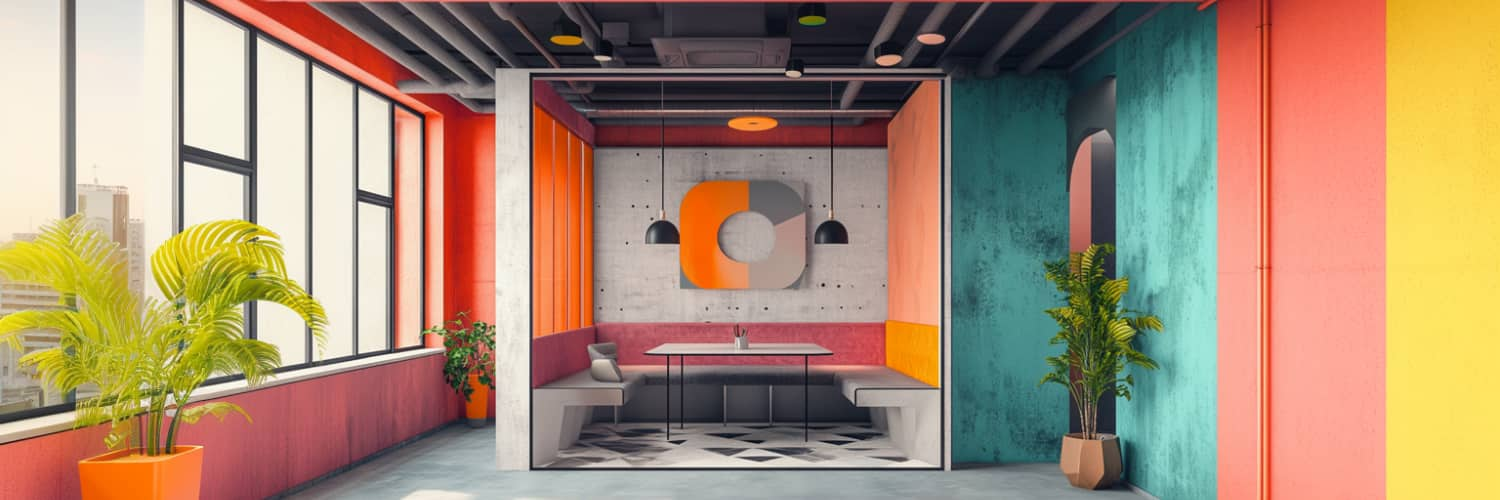In the ever-evolving landscape of professional environments, staying attuned to the latest office trends and the dynamic realm of modern office design has never been more crucial. The way we work and interact within office spaces is undergoing a profound transformation, driven by factors ranging from technological advancements to the evolving expectations of a diverse workforce.
74% of companies now offer hybrid arrangements, leading to offices shrinking but becoming more inviting and collaborative. This shift underscores the importance of adapting to new office trends to meet changing employee needs and expectations.
As we navigate these changes, it's essential to explore the ten office trends actively shaping the future of work. From innovative design concepts to flexible work arrangements, this article delves into the forefront of workplace evolution, offering insights into the trends driving productivity, engagement, and employee well-being in modern workplaces.
TL;DR:
- Modern office trends are crucial for staying competitive in evolving work environments.
- Office spaces have shifted from static to dynamic, fostering creativity and collaboration.
- Trends like hybrid work models offer flexibility and global talent acquisition opportunities.
- Wellness-centric design focuses on employee well-being, including lighting and ergonomic furniture.
- Technology integration improves efficiency, connectivity, and data-driven decision-making.
- Sustainable practices and biophilic design promote environmental responsibility and well-being.
- Flexible workspaces reduce real estate costs and accommodate diverse work styles.
- Collaboration spaces encourage innovation, inclusivity, and adaptability.
- Shorter commutes and accessible locations prioritize employee well-being.
- Activity-based workspaces customize environments for specific tasks and encourage collaboration.
- Office automation streamlines tasks and enhances productivity.
- Visual office navigation simplifies workspace navigation and supports remote work transitions.
- Adapting to these trends requires staying informed, embracing technology, and listening to employee feedback.
- Maximizing productivity with office space trends involves creating an environment that empowers employees.
- Staying attuned to evolving office trends is essential for sustainable growth and success in the modern era of work.
Embracing Modern Office Trends
Embracing modern office trends is pivotal for organizations seeking to remain competitive and adaptable in the fast-paced business world. The workplace is no longer a static setting but a dynamic entity that plays a pivotal role in attracting and retaining top talent, fostering innovation, and, ultimately, driving success.
Recent data shows that 84% of employees are more productive when they feel close to their teams, and 70% mention that they would be happier at work if they could foster deep connections with their colleagues. This highlights the importance of creating office environments facilitating strong team relationships and collaboration.
Modern office trends, from innovative design concepts to flexible work arrangements, can enhance employee morale, increase productivity, and create a more inclusive and agile work culture. Moreover, staying in tune with these trends showcases a commitment to staying relevant and responsive to the changing needs and expectations of the workforce, which can lead to improved recruitment, retention, and overall business performance.
In an era where the office is not just a physical space but a reflection of a company's ethos, embracing modern office trends becomes imperative for sustainable growth and success.
-1.png?width=928&height=523&name=Blog%20post%20photos%202%20(3)-1.png)
The Evolution of Office Spaces
The evolution of office spaces is a compelling story of adaptation and innovation in response to the evolving dynamics of the modern workforce. In the not-so-distant past, office environments were characterized by static cubicles and rigid structures, where employees often toiled in isolation. However, as our understanding of work and its relationship with employee productivity and satisfaction has evolved, so too have our office spaces.
A striking statistic reveals that by the middle of 2023, for the first time since 2000, there was less new office space built in the U.S. than torn down or repurposed, with 5 million square feet built and 14.7 million square feet closed. This trend underscores the significant shift in how we perceive and utilize office spaces.
Today, office spaces represent dynamic, versatile ecosystems that have transitioned from mere utilitarian constructs to hubs of creativity and collaboration. Open-plan layouts have emerged as a hallmark of this evolution, fostering spontaneous interactions among team members and breaking down the physical barriers that once defined the workplace.
Flexibility is another critical attribute of contemporary office space. The ability to adapt to different tasks and preferences is now essential.
The concept of office space design is no longer confined to aesthetics alone; it encompasses the holistic experience of work. Modern office spaces are engineered to enhance employee well-being, integrating ample natural light, ergonomic furniture, and biophilic design to create healthier and more inspiring work environments.
This transformation in office spaces is emblematic of a broader cultural shift in how we perceive work. It reflects a growing recognition that the physical environment plays a vital role in shaping how work gets done, the quality of work, and the overall employee experience. As we navigate the complexities of this evolution, we're discovering that innovative design concepts and agile spatial planning are reshaping not just the physical spaces we inhabit but the very essence of where and how we work.
10 Office Trends You Need to Prepare Your Workplace For
From modern office design concepts that blend aesthetics with functionality to the adoption of cutting-edge technology and innovative approaches to employee well-being, these trends are not just influencing the future of work but defining it. Explore the forces driving productivity, collaboration, and employee satisfaction in the modern professional world.
Hybrid Work Models
The first trend reshaping modern workplaces' landscape is hybrid work. As the global workforce experienced a seismic shift during the era of remote work, companies and employees found themselves in a novel terrain.
Hybrid work models balance the familiarity and camaraderie of the traditional office setting and the flexibility and autonomy of remote work. In this paradigm, employees can choose where and how they work. This flexibility caters to diverse work styles and preferences and amplifies opportunities for talent acquisition on a global scale. Companies embracing hybrid work models are positioning themselves for the future and demonstrating their commitment to a workforce that thrives in adaptable, dynamic environments.
The successful implementation of hybrid work models necessitates a thoughtful approach. It demands robust technological infrastructure to ensure seamless communication and collaboration, and it requires a shift in managerial practices towards outcome-based performance assessments rather than mere physical presence.
Wellness-Centered Design
In pursuing healthier, more productive office environments, the trend of wellness-centric design has risen to prominence. This transformative approach to office design places employee well-being at the forefront, recognizing that a harmonious workplace can significantly impact physical and mental health, job satisfaction, and overall productivity. Wellness-centric office design encompasses various elements, from optimizing lighting conditions to incorporating ergonomic furniture and introducing biophilic elements such as indoor plants. These considerations create aesthetically pleasing spaces and environments that invigorate and inspire those who inhabit them.
The importance of this office trend has only been magnified by recent global events, as organizations have been compelled to reevaluate the health and safety of their office spaces. These designs extend beyond the physical realm, encompassing wellness programs that support employees in maintaining a healthy work-life balance, managing stress, and prioritizing their mental health.
Technology Integration
Technology integration is a beacon of progress, fundamentally altering how we engage with our office environments - from IoT tools and smart rooms to how UGC creators broadcast and document office tech trends. The fusion of cutting-edge technology and the workplace has ushered in a new era of efficiency, collaboration, and innovation. Whether it's the seamless adoption of artificial intelligence (AI) to automate repetitive tasks or the widespread use of Internet of Things (IoT) devices to optimize office resources, technology integration is reshaping the way we operate and interact within office spaces.
This office trend transcends mere convenience; it's a strategic imperative. The modern workplace is no longer confined to a physical location; it's an ecosystem that thrives on connectivity and accessibility. Integrating technology empowers remote teams to collaborate effortlessly and ensures that every facet of work, from communication to project management, remains streamlined. It catalyzes innovation, driving companies to embrace digital transformation and leverage data analytics to make informed decisions.
Yet, as we embark on this technological journey, it's crucial to strike a balance. While technology integration enhances productivity and scalability, it also presents challenges, such as data security and continuous learning, to keep pace with evolving tools.
%20(1)-1.png?width=928&height=523&name=Blog%20post%20photos%202%20(2)%20(1)-1.png)
Sustainable Practices and Biophilic Office Design
Sustainable practices and biophilic design have emerged as significant trends in modern office spaces, reflecting a growing awareness of the environmental and psychological impact of the workplace. These two concepts address ecological concerns and promote employee well-being, creativity, and productivity. As organizations increasingly prioritize sustainability and employee satisfaction, integrating these principles into office design has become essential.
Sustainable practices in office design focus on minimizing the ecological footprint of the workspace. This includes using energy-efficient lighting, heating, and cooling systems and sourcing eco-friendly materials for furniture and construction. Incorporating renewable energy sources, such as solar panels, and adopting waste reduction strategies contribute to a more sustainable office environment. Beyond environmental benefits, sustainable practices can lead to long-term cost savings through reduced energy consumption and waste management expenses.
Biophilic design, on the other hand, draws inspiration from nature to create a workplace that fosters a deeper connection between employees and the environment. This office design trend incorporates natural elements like plants, natural light, and water features into the office space. Biophilic design is based on the idea that contact with nature can reduce stress, enhance creativity, and improve overall well-being. It aims to create a more harmonious and rejuvenating work environment, counteracting the stress and monotony often associated with traditional office settings.
Flexible Office Spaces
Flexible workspaces have swiftly risen to prominence as one of the most influential office trends shaping the future of workplaces and for good reason. This transformative trend reflects a profound shift in how we conceive, design, and utilize office spaces. Gone are the days of static cubicles and rigid layouts; flexible workspaces are all about versatility, adaptability, and meeting the diverse needs of a modern, dynamic workforce.
Open-plan layouts, hot-desking arrangements, and collaboration zones are integral components of this trend, encouraging spontaneous interactions, cross-functional teamwork, and the exchange of innovative ideas. Such environments foster creativity, boost employee engagement, and enhance overall productivity.
Another compelling aspect of flexible workspaces is their cost-efficiency. Companies can optimize space utilization, reduce real estate expenses, and accommodate fluctuating team sizes without major office overhauls. This economic advantage has made flexible workspaces a practical choice for businesses of all sizes, from startups to established corporations.
Collaboration Spaces
This office trend breaks away from traditional office setups, creating hubs where innovation and teamwork flourish. Collaboration spaces encourage spontaneous interactions and cross-functional collaborations by offering dedicated meeting pods, huddle rooms, and informal gathering areas. In an era where collaboration is the bedrock of creativity and problem-solving, these areas drive workplace productivity.
Collaboration spaces foster a sense of inclusivity and connectivity among employees, breaking down hierarchical barriers and encouraging the free exchange of ideas. These spaces are designed to be adaptable, accommodating various team sizes and needs, ensuring that different tasks and projects can thrive in the same environment. As businesses recognize the importance of teamwork and creativity, collaboration spaces have become a strategic investment in cultivating a collaborative, innovative, and agile workforce.
Furthermore, collaboration spaces align with the changing nature of work itself. With remote and hybrid work arrangements becoming increasingly prevalent, these spaces serve as central hubs for teams to convene, brainstorm, and build camaraderie. They empower companies to remain agile in a rapidly evolving business landscape, as flexibility and adaptability are key to success.
Shorter Commutes and Accessible Locations
In our fast-paced world, where the boundary between work and personal life can blur easily, shorter commutes and accessible locations are gaining profound significance. Companies increasingly recognize the pivotal role of office location in enhancing employee well-being and overall productivity.
The growing emphasis on work-life balance is a central driving force behind this office trend. Lengthy and stressful commutes have long been a pain point for employees, sapping both their time and energy. By strategically selecting accessible office locations, companies are alleviating this burden and making a resounding statement: that their workforce's health, happiness, and equilibrium matter. The proximity of offices to employees' homes and efficient public transportation options translate into shorter commute times, liberating individuals from the daily grind of traffic congestion and long train rides.
This trend signifies a holistic approach to workplace design that considers the overall well-being and satisfaction of employees. It recognizes that the physical location of the workplace is not just a logistical detail but a vital factor in enhancing work-life balance, promoting sustainability, and attracting and retaining talent.
Activity-Based Workspaces
This office trend recognizes that the one-size-fits-all, traditional office setup doesn't align with the modern workforce's diverse tasks and work styles. More companies are transitioning to activity-based workspaces, where the physical environment is strategically designed to accommodate various work activities, fostering a dynamic and productive atmosphere.
The core principle driving this trend is customization. Activity-based workspaces provide employees with the freedom to choose their work environment based on the specific task at hand. For instance, a collaborative project might call for an open and interactive area equipped with whiteboards and comfortable seating. At the same time, an individual requiring intense focus can opt for a quiet, secluded space for concentration. This adaptability empowers employees to optimize their work environments, enhancing their efficiency and engagement.
Furthermore, activity-based office spaces break down the traditional barriers that once separated departments and hierarchical levels. They foster organic interactions among team members, encouraging cross-functional collaboration and the spontaneous exchange of ideas. In such environments, the workplace becomes a fluid entity, evolving to meet the ever-changing needs of employees and the tasks they undertake.
Office Automation
Office automation is one of the most pivotal office trends in today's rapidly evolving professional landscape. As technology advances, organizations harness automation tools and solutions to streamline repetitive tasks, boost productivity, and enhance decision-making processes.
From workflow automation and document management to AI-powered data analytics, office automation reduces human error. It frees up valuable time for employees to focus on more creative and strategic aspects of their roles. This transformative office trend drives efficiency and reinforces the importance of staying at the forefront of technological innovation to remain competitive in the modern business world. As we journey further into the digital age, the transformative impact of office automation is poised to become increasingly central to the success and sustainability of businesses across various industries.
Visual Office Navigation and Wayfinding
One of the primary reasons why visual office navigation and wayfinding are paramount is the ability to enhance the employee experience. A well-designed, intuitive office layout with clear signage and visual cues minimizes the stress of navigating complex work environments. Employees can confidently find meeting rooms, collaborative spaces, and essential facilities, reducing frustration and saving valuable time. This boosts productivity and contributes to job satisfaction, as employees can focus more on their tasks and less on navigating labyrinthine office spaces.
Moreover, in an era where remote and hybrid work models are increasingly prevalent, ensuring a smooth office experience is vital. Visual navigation simplifies the transition from remote work to the office by providing clear directions and minimizing the anxiety that can arise from uncertainty about the office environment. Employees can seamlessly transition between different workspaces, whether they're hot-desking, collaborating with colleagues, or accessing specialized resources.
.png?width=928&height=523&name=Blog%20posts%20photo%20(11).png)
Adapting to Changing Office Trends
Adapting to these trends fosters a productive and engaging workplace and positions your company as a forward-thinking industry leader. Here are some key pieces of advice to help you adapt effectively:
- Stay informed: Monitor industry news, research, and reports on emerging office trends. Being informed about the latest developments will allow you to make informed decisions.
- Embrace technology: Invest in the right technologies that align with the evolving nature of work, such as office automation tools, collaboration platforms, and data analytics solutions.
- Listen to employee feedback: Actively seek feedback from employees about their preferences and needs in the workplace. Their insights are invaluable for tailoring office environments to their satisfaction.
- Make data-driven decisions: Leverage data analytics to make informed decisions about office layout, resource allocation, and employee productivity.
- Communicate: Maintain transparent and open communication channels with employees to keep them informed about changes and updates related to office trends.
- Experiment and iterate: Be willing to experiment with new ideas and iterate on office design and policies based on feedback and outcomes.
- Future-proof: Keep an eye on emerging technologies and trends that have the potential to reshape the workplace in the future, such as augmented reality, artificial intelligence, and the Internet of Things (IoT).
Maximizing Productivity with Office Space Trends
Maximizing productivity in the workplace is a perpetual goal, and aligning with the latest office space trends is a potent strategy to achieve this aim. By embracing flexible work arrangements, ergonomic designs, and collaborative spaces, organizations can create an environment that empowers employees to work at their best. Moreover, visual navigation and wellness initiatives contribute to a more efficient and healthier workplace, while technology integration and automation streamline processes, allowing teams to focus on high-impact tasks. In this dynamic landscape, staying attuned to evolving office space trends is the key to fostering productivity, engagement, and success in the modern workplace.
Summing It Up
The dynamic landscape of modern office design and workplace trends is a critical factor in shaping the future of work. These trends, ranging from hybrid work models to wellness-centered design and office automation, are influencing and defining how we work. Adapting to these trends is essential for organizations looking to remain competitive, attract top talent, and enhance productivity and employee well-being. Embracing these changes is not just about physical spaces; it's about fostering a culture of adaptability and innovation. As we navigate this evolving terrain, staying in tune with office trends is imperative for sustainable growth and success in the modern era of work.











